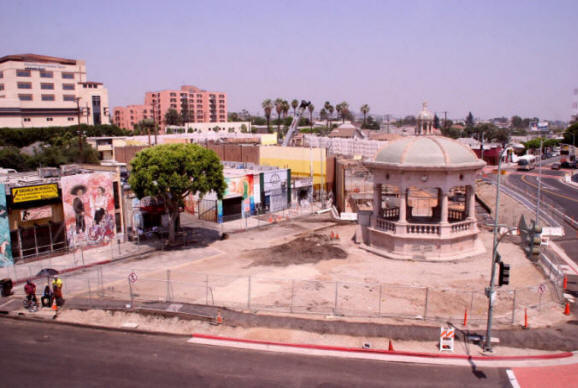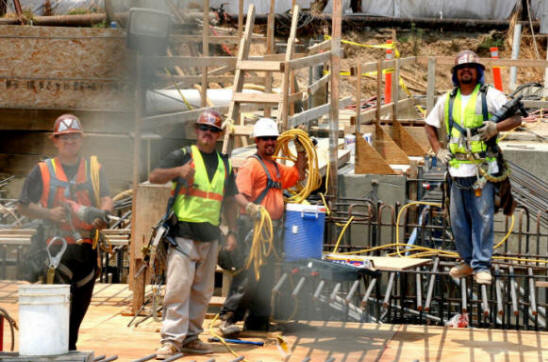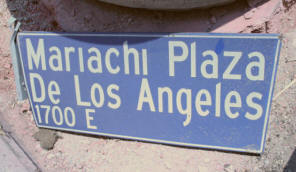University of California Berkeley Team Wins 2007 ULI Gerald D.
Hines Student Urban Design Competition
For more information, contact Marge Fahey at 202/624-7187 or E-mail mfahey@uli.org
WASHINGTON (April 2, 2007) — A development proposal drafted by the University of California Berkeley team to redevelop a 16.5-acre block in Los Angeles has been selected as the winning scheme in the fifth annual ULI (Urban Land Institute) Gerald D. Hines Student Urban Design Competition. The team's entry was selected over plans submitted by other competition finalist teams from the University of Illinois at Urbana-Champaign and two teams from Harvard University.
The graduate student teams, competing in a student ideas competition, were charged with forming a quasi-public agency to redevelop the East First Street corridor from Alameda to Mariachi Plaza, taking into consideration connections to neighborhoods, to a revitalized Los Angeles River proposed in the newly-issued master plan, to the new Gold Line Eastside Extension, and the development of the construction staging sites surrounding Mariachi Plaza after the MTA completes the subway entrance.
The winning team was announced after the final round of the competition, which was held in Los Angeles on March 30, 2007. “Tectonics was a very clear concept about the need to introduce open space into the community and to reconnect the river as a focus and connection, both east and west,” said jury chair, William Gilchrist, director of planning for the City of Birmingham, Alabama.
The ULI Gerald D. Hines Student Urban Design Competition was created in 2002 to honor the legacy of urban development pioneer Gerald D. Hines, chairman of the Hines real estate organization and the 2002 recipient of the ULI J.C. Nichols Prize for Visionaries in Urban Development. The competition is open to graduate students who are pursuing real estate-related studies at a North American university, including programs in real estate development, city planning, urban design, architecture and landscape architecture.
As the winner, the interdisciplinary University of California Berkeley team was awarded a $50,000 prize. Team members were Christopher Lollini, Andrea Gaffney, Robert McCracken, Aditi Rao, and Brooke Ray Smith. The three remaining finalist teams each received $10,000. The competition is designed as an exercise; there is no guarantee or expectation that the students' plans will be implemented as part of any revitalization of the site.
The First Street corridor has attracted major redevelopment in the past decade, including the Walt Disney Concert Hall, the Gold Line Eastside Extension, Caltrans' district headquarters building, the Japanese American National Museum, and the Pueblo del Sol, mixed-income housing development. In addition, a new public high school is under construction. In 2006, construction began on an eight-station, six-mile extension of the Gold Line light rail line into East Los Angeles from Union Station.
Back to Top
The competition was held in two stages. In the first stage, 93 teams from 26 universities submitted solutions to an 11-day charette-like planning, designing and development exercise of a master plan for East First Street from Alameda to Mariachi Plaza, an urban design for the portion of the Los Angeles River from the 101 Freeway to the Sixth Street Bridge, and a redevelopment scheme for the MTA construction staging parcels surrounding the new Mariachi Plaza subway entrance. The development challenge for the students was to propose an economically- and environmentally-sustainable mixed-use development that would connect the downtown, Little Tokyo, Arts District and Boyle Heights neighborhoods that are cut off from each other by the north-south, elevated Santa Ana and Golden State freeways.
In the second stage, a team member of each of the four finalist teams was sent to Los Angeles, and the teams were given a new challenge: to propose a mixed-use development for the 16.5-acre city-owned site at First and Alameda.
The winning redevelopment plan, “Tectonics” refers to the metamorphic process of creating new landscapes by forming connections between disparate fragments of Los Angeles’ neighborhoods. The urban plan for East First Street encourages a flow of green spaces towards a new park decked over the railyards along the west side of the river, and connecting to the greenway along the east side of the river. This urban-scale swath of green space continues into the residential neighborhoods in Boyle Heights, up to Mariachi Plaza, which is redeveloped with residential rental and ownership units, both market-rate and affordable, above neighborhood-scale retail spaces. “Addressing local needs for open space, recreational, commercial, and entertainment amenities, this tectonic green network connects the core of Los Angeles along critical veins of nature and life,” as stated in the plan.
Jury members commended the winning team for its boldness in reconnecting the river to the communities and for designing a scheme that ensured connectivity to the surrounding neighborhoods, both East and West. “The initial proposal was very bold and clear,” said Mark Johnson, president, Civitas in Denver. “It addresses what is widely known as a problem with Los Angeles; a very poor distribution of open space available to people of mixed means.”
For more information, contact Marge Fahey at 202/624-7187 or E-mail mfahey@uli.org
Industry Topics: Urban Design
|









I knew this was going to happen. Ugh. Hopefully, once it's constructed, the
mariachis can go back and enjoy their way of life.
¡Saludos, compadres!
middle of an active construction site? This article smacks of reverse racism to me.
It's news because this disrupts their job. They typically stand there, not playing,
but waiting for someone to come and hire them. That's how they pay the rent,
feed themselves and their family, and to have a construction site disrupt the way
in which they earn money is newsworthy. The mariachis have been there for a
very, very long time, and I know that if someone goes there and does not see the
mariachis where they typically are and does not know where to look for them,
the mariachis aren't hired.
How is this article in any way emblematic of reverse racism?
Right. And no one else has ever had their jobs and livelihoods disrupted by
public construction projects before.
This rail extension will benefit the area (in the long run) much more than these
musicians' income ever will. I commend them for moving to their new location
without too much fuss. I do hope the musicians can either continue to find work
or find some other way to support themselves while construction continues, but
markets change and people have to adapt.
"This rail extension will benefit the area (in the long run) much more than these
musicians' income ever will. "
How about "This rail extension will benefit the musicians"? Why are we forced
to choose between mariachis and quality transportation? Yes it will be difficult
for them now. But once the line is built they will benefit from the increased
mobility of a rail line. The gold line is not a racist ploy, and mariachis are not
enemies of free market economics.
I had no intention of characterizing the musicians as enemies of anything, nor
did I mean to imply that a choice between mariachis and transportation was
required. I simply meant that the overall good that will come from this rail
extension will more than make up for the temporary loss and inconvenience it
has caused, on both community and individual levels.
I look forward to the return of the mariachis to their accustomed place, and
again, I respect their willingness to make temporary sacrifices for the greater
good. I think you and I are in agreement on this. Thanks for helping me clarify
my thoughts.
Public works projects always get in the way with businesses for awhile, but in
the long run they benefit everyone. Once the new plaza is complete it will be
a great thing for the musicians ... they just need to wait a little, but that's life.